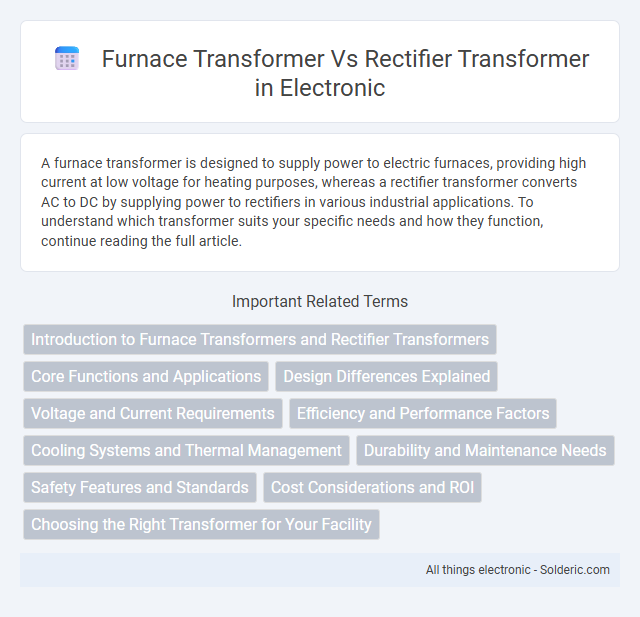A furnace transformer is designed to supply power to electric furnaces, providing high current at low voltage for heating purposes, whereas a rectifier transformer converts AC to DC by supplying power to rectifiers in various industrial applications. To understand which transformer suits your specific needs and how they function, continue reading the full article.
Comparison Table
| Feature | Furnace Transformer | Rectifier Transformer |
|---|---|---|
| Purpose | Supplies power to electric arc furnaces | Supplies power to controlled rectifier circuits |
| Output Type | AC (Alternating Current) | AC for rectification, often multi-tapped |
| Voltage | Low voltage, high current output | Low voltage output optimized for rectification |
| Current Rating | Very high current capacity (usually thousands of amperes) | High current, designed for controlled DC output |
| Cooling | Oil or water cooled depending on rating | Oil cooled, sometimes with forced air/water cooling |
| Design Features | Robust winding to withstand short circuits and electrical arcs | Multi-secondary windings with special insulation for rectifier valves |
| Usage | Steel industry, electric arc furnace operation | Industrial DC power supplies, electroplating, welding power |
| Cost | Generally lower cost due to simpler design | Higher cost due to complex winding and insulation |
Introduction to Furnace Transformers and Rectifier Transformers
Furnace transformers are specialized electrical devices designed to supply power to electric arc furnaces, optimizing voltage levels for industrial melting processes. Rectifier transformers convert alternating current (AC) to direct current (DC) by working alongside rectifier units, essential for applications like electroplating and DC welding. Understanding the distinct roles of furnace and rectifier transformers helps you select the right transformer to meet specific industrial power requirements.
Core Functions and Applications
Furnace transformers primarily convert high voltage to low voltage and high current, supplying power to electric arc furnaces in steelmaking processes, ensuring stable current for melting metal. Rectifier transformers, designed to work with rectifiers, convert AC voltage to DC voltage, crucial in applications such as electroplating, welding, and industrial DC power supply. Both transformers are essential in heavy industrial environments but differ in their electrical output and specific role within power systems.
Design Differences Explained
Furnace transformers feature robust design with high thermal capacity and low voltage ratios, tailored for supplying electric arc furnaces with stable power under extreme conditions. Rectifier transformers incorporate multiple secondary windings and specialized insulation to convert AC to DC efficiently, supporting heavy industrial rectification processes. Your choice hinges on the specific application requirements, where furnace transformers prioritize durability and heat resistance, while rectifier transformers emphasize electrical conversion and flexibility.
Voltage and Current Requirements
Furnace transformers operate at high voltages, typically ranging from 2,300 to 13,800 volts, and deliver low current designed for electric arc furnaces, enabling precise control of the melting process. Rectifier transformers, by contrast, convert high-voltage alternating current (AC) to lower voltage direct current (DC), accommodating higher current loads necessary for applications like electroplating or DC arc furnaces. Understanding the distinct voltage and current requirements of your application ensures optimal transformer selection for efficiency and safety.
Efficiency and Performance Factors
Furnace transformers offer high efficiency by providing stable voltage and current specifically designed for electric arc furnaces, minimizing energy loss and ensuring optimal performance in heavy industrial applications. Rectifier transformers are optimized for converting AC to DC power with low harmonic distortion and improved voltage regulation, enhancing the overall efficiency of DC-driven systems. Understanding these performance factors helps you select the right transformer, ensuring reliable operation and reduced energy consumption in your specific application.
Cooling Systems and Thermal Management
Furnace transformers typically incorporate robust cooling systems such as oil-immersed or air-forced cooling to manage the high heat generated during heavy industrial operations. Rectifier transformers often feature advanced forced air or water-cooling mechanisms designed to dissipate heat from both the transformer core and semiconductors, enhancing thermal stability. Effective thermal management in both types minimizes temperature rise, prolongs equipment lifespan, and ensures consistent performance under demanding electrical loads.
Durability and Maintenance Needs
Furnace transformers are designed with robust insulation and heavy-duty cores to withstand high-temperature environments, resulting in greater durability and lower maintenance demands. Rectifier transformers experience more stress due to rectification processes and harmonic currents, which can lead to increased wear and higher maintenance frequency. Selecting a furnace transformer reduces downtime and maintenance costs in industrial heating applications compared to rectifier transformers.
Safety Features and Standards
Furnace transformers and rectifier transformers are designed with distinct safety features tailored to their specific industrial applications, where furnace transformers incorporate robust insulation and cooling systems to handle high short-circuit currents and thermal stresses. Rectifier transformers prioritize protection against overvoltage and harmonic distortions, integrating features such as electrostatic shields and regulated tap changers to ensure stable DC output and prevent electrical faults. Both types strictly adhere to international standards like IEEE, IEC, and ANSI, ensuring compliance with operational safety, insulation coordination, and environmental regulations.
Cost Considerations and ROI
Furnace transformers generally have a higher upfront cost due to their robust design and capacity to handle heavy industrial loads, while rectifier transformers tend to be more cost-effective for applications requiring conversion from AC to DC power. The return on investment (ROI) for furnace transformers can be justified by their durability and efficiency in high-demand environments, whereas rectifier transformers provide quicker ROI through energy savings and reduced maintenance in processes involving DC supply. Your choice should consider the specific load requirements, operational efficiency, and long-term cost benefits tied to each transformer type.
Choosing the Right Transformer for Your Facility
Selecting the right transformer for your facility hinges on understanding the specific requirements of furnace transformers and rectifier transformers. Furnace transformers are designed to handle high currents at low voltages, catering to electric arc furnaces and similar heavy industrial applications. Rectifier transformers convert AC to DC by feeding rectifiers, making them essential in processes requiring stable DC power, so assess your operational needs carefully to ensure optimal performance and energy efficiency.
furnace transformer vs rectifier transformer Infographic

 solderic.com
solderic.com